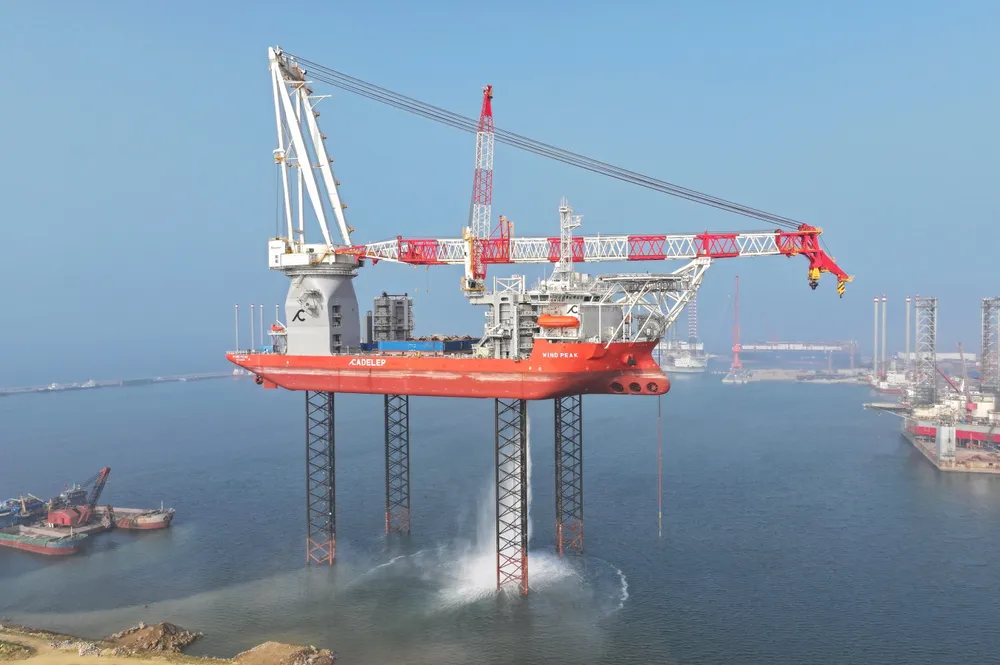'Shocking' O&M demand gives offshore wind vessels giant Cadeler a lucrative side hustle
CEO sees transport and installation as 'string of pearls knitted together by operations and maintenance', resulting in high offshore wind vessel utilisation

A shift toward multi-vessel projects and a fast-maturing O&M market is allowing Cadeler to obtain “very high rates of utilisation” from the world’s largest fleet of specialised offshore wind vessels, the company said.
In Cadeler's quarterly earnings call with analysts, CEO Mikkel Gleerup highlighted progress in expanding and modernising the company's fleet, but was also keen to stress advantages he says accompany this growth.
Cadeler completed its merger with former rival Eneti one year ago and currently has eleven vessels, including seven newbuilds and two upgrades.
Gleerup said this incremental contract is part of a wider trend in which burgeoning demand for O&M work is "vacuuming up any spare demand" and allowing Cadeler to achieve "very high rates of utilisation."
'Shocked by demand'
Gleerup claimed the size and versatility of Cadeler's fleet is allowing it to take advantage of an O&M market that he admits has surprised him by the strength of demand generated.
"I see several clients lining up for every piece of available capacity we have at the moment. I have been shocked by demand. Clients sometimes see obtaining a vessel as an opportunity to to get a lot fixed in one go," he said.
Multi-vessel gigs
The Cadeler CEO also highlighted what was described as a growing trend towards multi-vessel deployment at projects.
Both new projects added to Cadeler's contractual backlog during the third quarter illustrated the point. Both jobs are scheduled for 2027.
Cadeler also signed contracts for its vessels to install 64 foundations and 15MW turbines for the East Anglia 2 Offshore Wind Farm, being developed by ScottishPower Renewables off the coast of the UK.
The multi-vessel trend is especially evident for bigger, more complex projects.
"A larger fleet means can you can cover the risk of gaps more. Having this kind of versatility means you can make vessels available just to support or speed up a project, for example," Gleerup said.
He also described a picture where the growing standardisation of vessels gave clients the confidence to book a class of vessel, rather than a specific unit, building versatility into the backlog and mitigating risk.
Overall, Cadeler described a picture of surging demand, with O&M playing an increasingly important role in this.
"We continue to to see very strong demand for services in the wind turbine and foundation spaces. O&M fills up any gaps in utilisation we have available," said the Cadeler boss said, describing transport and installation projects as "a string of pearls, knit together tightly by O&M".
O&M risks
While O&M was described as less risky than installation, Gleerup noted that it offers less scope for repetition and standardisation than installation.
"O&M means you are using different ports and sites, with different clients and equipment, so the demands onshore and offshore can be higher. But having an O&M component in between installation jobs still makes a great deal of sense," he said.
Gleerup admitted that making spot capacity available in this way can sometimes be a source of tension.
"It has to be done in right way. We try to mitigate so we don't create new bottlenecks. Sometimes you can't give them as much incremental time as they want," he added.
Cadeler is continuing with its fleet expansion, having placed an order for third A-Class vessel.
The company expects to take delivery of four WTIVs next year and, amid expectations of increased tender activity for foundation installation, has ordered a third A-Class vessel for this sector.
Cadeler's expected vessel deliveries
Vessel Expected Delivery Percentage Executed
- Wind Pace 2Q 2025 99%
- Wind Mover Q4 2025 57%
- Wind Ally Q4 2025 74%
- Wind Ace Q3 2026 14%
- Wind Apex Q2 2027 First steel cut expected July 2025
Gleerup said it has become "incredibly difficult" to get a yard slot. "If you can get a yard slot and you have a completed design ready with detailed engineering, you are still lucky if you can delivery in four or five years," he noted.
Global mix
Cadeler, which reported a record contractual backlog of €4.8bn ($5.06bn) in the third quarter, is currently carrying out transport and installation work for the Revolution project off New York and expects to retain the US market in its portfolio, despite the lowering of expectations for the sector there.
Gleerup said fast growth in Europe, with "very strong commitments" in markets such as the UK, Germany and Poland would ensure continued focus there, and also in the Asia-Pacific region, "for similar reasons."
We will take a balanced approach in the Americas, because the other two markets are growing significantly faster," he said
"We see projects in the US that are accretive to what we do, but if we want capital to work there it has to be with very strong mitigation because we want to make sure vessels [are] working when booked to work," he added.
(Copyright)